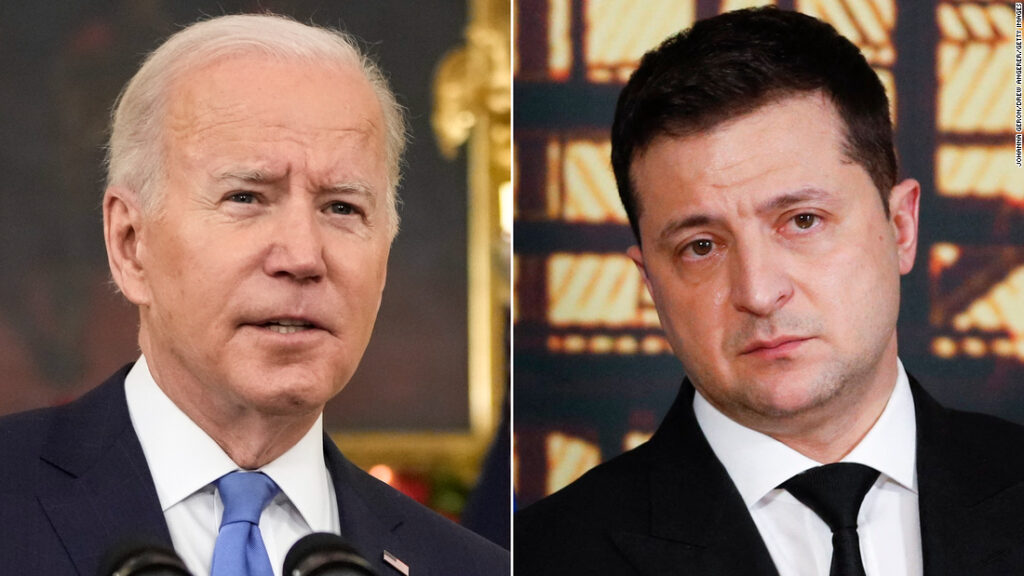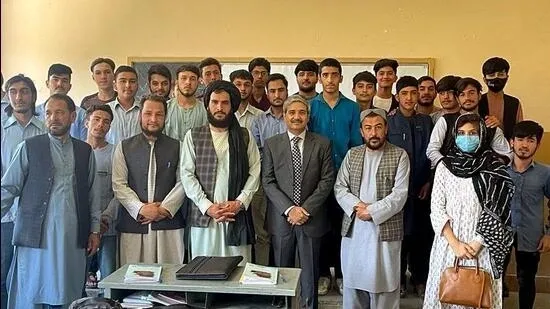
By Professor Habib Al-Badawi
The evolving geopolitical landscape, marked by hotspots like Ukraine and contested regions such as Taiwan, presents the United States with an intricate challenge: how to support its allies while navigating the complexities of formidable adversaries? The delicate issue of providing arms has ignited discussions about the imminent need for the U.S. to strategically prioritize its support for both Ukraine and Taiwan.
As policymakers in Washington approach decisions on new military aid for Ukraine, Taiwan, and Israel, concerns have surfaced regarding the capacity of the U.S. industrial base to meet the escalating global demand for American arms.
Before the recent genocide in Gaza was committed with American ammunition, the United States grappled with weapons overlap between platforms designated for Kyiv and those earmarked for Taipei. Should Congress endorse President Biden’s plea for additional aid to Ukraine, the tradeoff between arming Ukraine and Taiwan is set to become increasingly critical in 2024 and beyond. This nuanced scenario has given rise to two divergent schools of thought among experts.
Optimists, including senior U.S. and Taiwanese officials, downplay the overlap, asserting that increased support for Ukraine will not detrimentally affect Taiwan. On the contrary, pessimists contend that prolonged support for Ukraine could exacerbate the backlog of U.S. weapons intended for Taiwan, underscoring the strategic imperative of prioritizing support for Taiwan. The pessimist approach foresees the U.S. being compelled to make challenging decisions on how best to support both beleaguered friends within the constraints of limited resources.
One strategic consideration is the potential freezing of new foreign military sales to European allies, allowing the U.S. to refocus on meeting the pressing needs of Taiwan. While historically, most U.S. military aid to Ukraine followed different channels than arms sales to Taiwan, the evolving demands on the U.S. defence industry present a significant and unavoidable challenge.
The narrative unfolds as we delve into the specifics of each pressure point, highlighting the complexities and interdependencies that characterize the current geopolitical landscape. To navigate this intricate web effectively, strategic policy actions are recommended, encompassing cautious approaches to FMS sales, fostering weapons co-production with Taiwan, and engaging in candid discussions with Ukraine about the limits of U.S. military aid. These recommendations are designed to address immediate challenges while charting a path toward the security and stability of both Ukraine and Taiwan.
Accordingly, as the world grapples with geopolitical uncertainties, the United States is tasked with adeptly navigating the delicate balance of supporting its allies amid evolving threats. The recommendations put forth aim to guide strategic decision-making, ensuring the security and stability of both nations while addressing the pressing challenges faced by the U.S. in the realm of defence production and international relations.
From the geopolitical hotspots of Ukraine to the contested waters around Taiwan, the United States finds itself facing the challenge of supporting its allies while facing formidable adversaries. The provision of arms has become a delicate issue, prompting discussions about the imminent need for the U.S. to prioritize its support for Ukraine and Taiwan.
As lawmakers in Washington inch closer to authorizing new military aid for Ukraine, Taiwan, and Israel, concerns loom over the capacity of the U.S. industrial base to meet the surging global demand for American arms. Even before the recent conflict in Gaza, the U.S. grappled with weapons overlap between platforms destined for Kyiv and those earmarked for Taipei. If Congress greenlights President Biden’s request for additional aid to Ukraine, the tradeoff between arming Ukraine and Taiwan is poised to become even more critical in 2024 and beyond.
Discussions about these trade-offs have spawned two schools of thought. Optimists, including senior U.S. and Taiwanese officials, downplay the overlap, asserting that increased support for Ukraine does not negatively impact Taiwan. Pessimists, however, contend that prolonged support for Ukraine could worsen the backlog of U.S. weapons intended for Taiwan, emphasizing the strategic imperative of arming Taiwan.
The pessimistic approach foresees the U.S. being compelled to make difficult choices about how best to support both beleaguered friends with limited resources. One strategic consideration is the potential freezing of new foreign military sales to European allies, allowing European industry to assume a greater burden while the U.S. focuses on meeting Taiwan’s needs.
Historically, most U.S. military aid to Ukraine has followed different channels than arms sales to Taiwan. However, this is expected to change as defence production lines grapple with the demand for new weapons for Taiwan, Ukraine, NATO states, and other allies. These evolving demands on the U.S. defence industry pose a significant challenge that cannot be ignored.
Three key pressure points are demanding immediate attention: Foreign Military Sales (FMS) to NATO, the overlapping weapons covered by the Ukraine Security Assistance Initiative (USAI), and the increasing number of overlapping weapons sent to Ukraine through the Presidential Drawdown Authority (PDA) that will necessitate replenishment. By dissecting these pressure points, we aim to provide comprehensive insights into the intricate web of challenges posed by the Ukraine-Taiwan weapons overlap.
Most U.S. arms sales to Taiwan occur through FMS, involving a more protracted review process and the construction of weapons from scratch. Presently, Taiwan awaits the delivery of approximately $19 billion worth of weapons sold through FMS. The overlap between Taiwan and other U.S. allies, particularly NATO states, has grown considerably since the commencement of the war in Ukraine. A substantial number of FMS announcements now contain weapons overlapping Taiwan’s backlog.

USAI, designed to fund contracts with the U.S. defence industry for building new weapons for Ukraine, presents another challenge. Out of the 17 USAI announcements made since February 2022, 10 involve capabilities that overlap with Taiwan’s backlog, placing additional stress on U.S. production lines over a shorter time limit.
A growing stockpile of weapons received by Ukraine through PDA is the final concern. While the current Ukraine-Taiwan PDA overlap is minimal, replenishing U.S. equipment transferred to Ukraine could strain existing production capacity. Taiwan may find itself at the back of the line for weapon delivery priority, contending with U.S. stockpile replenishment, Ukraine USAI sales, and other FMS customers.
To navigate the intricate web of challenges posed by the Ukraine-Taiwan weapons overlap, several policy actions are recommended:
- Promoting weapons co-production with Taiwan could be instrumental. Allowing Taiwanese companies to build U.S. weapons under license, either partially or in full, could expedite the delivery of backlogged weapons and concurrently enhance Taiwan’s defence industry capacity.
- The U.S. needs to engage in candid discussions with Ukraine about the limits of U.S. military aid. The Biden administration’s assertions of open-ended support are encountering scepticism in Congress, which is wary of maintaining indefinite financial commitments.
- This political friction, compounded by concerns about the capacity of the U.S. industrial base, may necessitate a reevaluation of American support for Ukraine in 2024, possibly resulting in a less expansive approach than witnessed in previous years.
- The U.S. should exercise caution in announcing additional FMS sales to NATO states, freeing up defence industrial capacity and incentivizing greater European investment in their industrial base.
Accordingly, as the geopolitical landscape continues to evolve, the United States must adeptly navigate the delicate balance of supporting its allies in the face of evolving threats. The intricacies of managing military aid to both Ukraine and Taiwan demand a nuanced and strategic approach, considering the finite resources at the U.S.’s disposal and the ever-changing global political dynamics.
The recommendations put forth aim to chart a path that ensures the security and stability of both beleaguered nations while addressing the pressing challenges faced by the U.S. in the realm of defence production and international relations.
On the other hand, the potential responses from Russia and China to the situation involving U.S. military aid to Ukraine and Taiwan would depend on a range of factors, including their geopolitical interests, strategic considerations, and the evolving dynamics of international relations. Here are some hypothetical responses that these countries might consider:
Russia:
- Geopolitical Maneuvering: Russia could seek to strengthen its alliances and partnerships, especially with countries critical of U.S. actions. This might involve closer cooperation with other nations facing challenges from the U.S. or efforts to exploit divisions within Western alliances.
- Military Maneuvers: Russia might conduct military exercises near its borders with Ukraine, sending a signal of strength and emphasizing its security concerns. Such manoeuvres could be seen as a response to perceived provocations from increased U.S. military aid to Ukraine.
- Propaganda and Information Warfare: Russia might engage in information warfare to shape the narrative surrounding U.S. actions. This could include disinformation campaigns aimed at undermining U.S. credibility or influencing public opinion.
- Protest and Diplomatic Pressure: Russia could express strong objections and protest what it perceives as increased U.S. interference in regions it considers within its sphere of influence. Diplomatic channels may be utilized to voice concerns and attempt to influence U.S. policy.
China:
- Closer Ties with Russia: In response to shared concerns about U.S. involvement in their respective spheres of influence, China and Russia might strengthen their strategic partnership. This could include enhanced military cooperation, joint diplomatic initiatives, or economic collaborations.
- Diplomatic Posturing: China may issue diplomatic statements expressing concern about U.S. actions and emphasizing the principle of non-interference in the internal affairs of sovereign nations. They could leverage international forums to voice their objections.
- Economic Measures: China could use economic leverage, such as adjusting trade policies or implementing sanctions, to register its dissatisfaction with U.S. actions. Economic measures could serve as a tool to deter further interference.
- Increased Military Presence: Depending on the severity of the perceived threat to its interests, China might increase its military presence in areas of strategic importance, asserting its regional influence and signalling a robust response to what it views as U.S. interference.
It is important to note that these are speculative responses, and the actual reactions of Russia and China would depend on the specific circumstances, diplomatic efforts, and the overall global geopolitical landscape at the time. Additionally, international pressure, negotiations, and the involvement of other key players could influence the course of events.
In conclusion, as the world navigates the complexities of geopolitical tensions and potential conflicts, it is crucial to emphasize the pursuit of lasting peace and diplomatic resolutions. The challenges posed by situations like the allocation of U.S. military aid to Ukraine and Taiwan underscore the delicate nature of international relations. Instead of fostering an environment marked by hostility and brinkmanship, it is in the best interest of nations to prioritize dialogue, cooperation, and diplomatic solutions.
World peace is not merely an idealistic aspiration; it is an attainable goal that requires collective efforts, understanding, and a commitment to resolving disputes through peaceful means. The interconnectedness of our global community necessitates a shared responsibility to foster harmony, build bridges, and seek common ground.
In the face of differing perspectives and potential tensions, promoting open communication, mutual respect, and collaboration becomes paramount. Diplomacy should be the preferred avenue for addressing disagreements, fostering understanding, and building relationships based on trust.
As we reflect on the challenges of our time, let us remember that history has shown the devastating consequences of conflicts and wars. By choosing the path of dialogue over confrontation, nations can contribute to a more stable and secure world. The pursuit of world peace requires courage, compromise, and a commitment to finding solutions that benefit all of humanity.
In the words of Mahatma Gandhi, “You must be the change you want to see in the world.” Each nation has the power to influence the global narrative, and by prioritizing peace, we can collectively build a future where international relations are characterized by cooperation, understanding, and shared prosperity. Let our shared commitment to world peace guide our actions and decisions, ensuring a legacy of harmony for generations to come.
Bibliography
- Foreign Military Sales (FMS): https://www.dsca.mil/foreign-military-sales-fms
The North Atlantic Treaty Organization (NATO): https://www.nato.int/
- Ukraine Security Assistance Initiative (USAI): https://ua.usembassy.gov/tag/ukraine-security-assistance-initiative-usai/
- Presidential Drawdown Authority (PDA): https://www.state.gov/use-of-presidential-drawdown-authority-for-military-assistance-for-ukraine/



